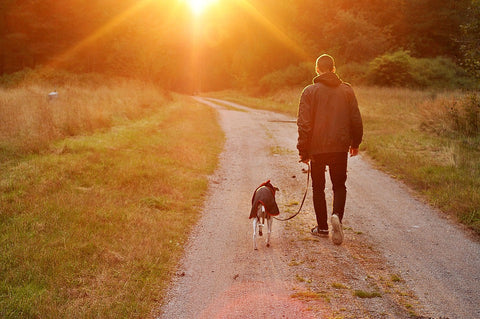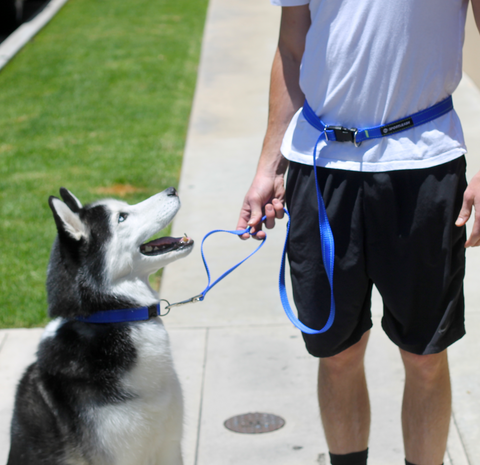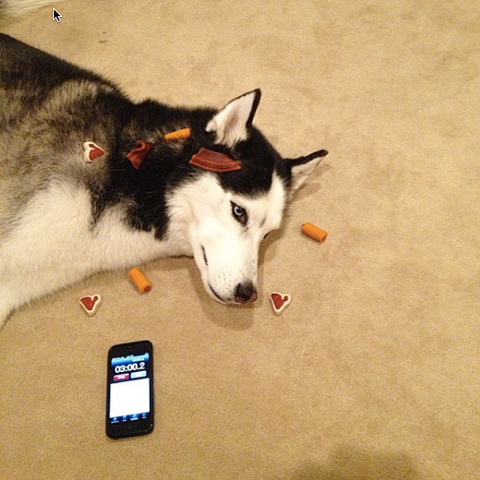Just like any other behavior you want to condition your dog to do, leash training is really no different. The main reason the leash pulling gets so much negative 'draw' is because it's one a dog's more negative behaviors that affects us most...ie getting pulled is uncomfortable....but dogs jumping up on to the couch, or watching us eat, or even excessive barking are all negative behaviors that can be conditioned with the proper attention and reinforcement. There are a few tricks and methods to apply, but for the most part applying the principles below will help you train your dog to do essentially whatever you want.
But first...why do dogs pull?
Contrary to popular believe, the reason for your dog pulling has nothing to do with him trying to be the Alpha...or the pack leader...or trying to be in control...dogs simply are highly stimulate or overstimulated (especially the younger pups) and dying to explore their surroundings. Think about this...a human can hear frequencies up to about 2,000 Hz. whereas dogs hear up to 8,000 Hz. At the same time a dogs sense of smell is up to 10,000 - 100,000 times more acute as that of humans. In other words, think of walking in a noisy world at 18" off the ground where you can't see a whole hell of a lot and you're overwhelmed by a thousands different smells. It seems like a fanatical little world...and it is for your dog...it's exciting...and all they want to do is explore. The first part of training your dog is to know that this is a NATURAL behavior. What you want to train them is NOT a natural behavior...it's trained. And it takes time, patience, and plenty of reinforcements...but it's doable and we'll show you how below!
The first thing you have to understand when training any dog is that dogs are pack animals. You've heard that they "need an Alpha"...while this is essentially true, what it really means is they need someone in control...they feel more comfortable when they are guided on what to do and how to act. That's all you...so when you see dogs acting poorly...remember dogs can't teach themselves...it's not the dog...it's the human.

So now that we have that down...the first step in training your dog on the leash is to apply that control while walking your dog. Your dog needs to understand that YOU are walking HIM...not vice versa. It's ok to let your dog stop and sniff the bushes or the telephone poll and enlighten his senses, but not excessively. Keep a steady pace so your dog continues to walk...once he understands that he can't stop and sniff every single thing that he wants...he'll understand that you're in control and be more open to other reinforcement techniques to improve his conditioning.
To the last point on conditioning your dog to walk on your terms and to prohibit him from running all over the place during the walk, it's good to start your dog out with the right equipment to make your life easier.

You don't want your dog 15 feet ahead of you. That gives your dog complete control over the walk...you want your dog, especially during leash training, to be on a short leash or by using the short leash in your leash to keep them close (our leashes have these built in here if you're interested). This establishes and reinforces every 2-3 feet that "oh there's my owner again, I have to stay close to him"...if you have the 15 foot leash...that reinforcement happens maybe 3 times a walk when the leash buckles...that's not enough reinforcement stimulus to drive home the point.
Additionally, an easy way to ensure your dog is not pulling is having his collar adjusted correctly. Many people allow the collar to slip far down the neck which give you less control with the leash. What you want to do is apply the collar higher up on the neck just under the dogs jaw. This does not hurt the dog, but it places the collar (and subsequent pressure) in a more controllable position...ie if your dog pulls at this position he's going to twist his head...which again...stimulus that he's going to eventually remember "I don't like that...I'm not going to do that".
Lastly, some people recommend various equipment such as harnesses and/or training collars to help with the process. You can certainly get away with the standard leash/collar combo, but may serve as additional help for the more stubborn dogs.
Dog's are not like humans...you remember your mom telling you "if I've told you once, I've told you a thousand times". That's not how it works with dogs...just because you've told your dog or taught your dog how to do something does not mean that it's forever going to stick. One of the most crucial parts of dog training (that people tend to forget) is that conditioning for even the slightest positive or negative behavior should be a daily routine. Our 12 year old husky still gets told (or reminded) that he's a good boy if he waits for his treat....even if that's 3 minutes later.

The point is..dogs love to please you. If they know if they pleased you the first few times they want to continue doing that behavior...but if you stop conditioning them, they will eventually lose focus that it still does please you and that behavior may fade.
So when you're walking your dog and he's exhibiting good behavior...ie a loose leash...there needs to be plenty of positive reinforcement. A good technique to try is small 20 yard increments at a time holding the short leash (2-3 feet way at most). See if you can keep your dog to focus on walking slowly forward, not pulling on the leash...and if he does positive reinforcement. If he does not a slight (not hard) pull of the leash just to get his attention with a negative reinforcement command (no). Continue doing this throughout your walks. When you have this down and/or if you want to compliment this what you can do is open the leash up to the normal 6 foot length and then try the reverse direction. So during the walk suddenly and randomly walk in a different direction. This isn't to just toy with your dog...this will get him accustom to remembering to pay attention to you as you lead the walk. If you can nail these 2 things off the bat you're off to a good start.
 Lastly, is the driving the point home. Similar to the point in the last section most of this
Lastly, is the driving the point home. Similar to the point in the last section most of this
is about doggy psychology. Once a dog knows you're in charge, he's set up with the right equipment to keep him focused, and you're practicing the proper walking techniques the only thing you need to do is practice, practice, practice (after all it does make perfection) and reinforce. For the more common conditioning on the walks verbal commands will suffice, but if you're just getting started or practicing the 20 yard increments described above it wouldn't be a bad idea to give a sliver of a treat ever time the dog completes the exercise correctly. Again, dogs love positive reinforcement...the stronger the magnet (ie the treat), the more likely they will "get it" and connect the dots as to what drove the action...at that point they just want to continue to make mom and dad happy!
Reynold Krieg
Feb 22, 2017